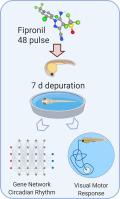Comparative Biochemistry and Physiology D: Genomics & Proteomics ( IF 3 ) Pub Date : 2020-09-11 , DOI: 10.1016/j.cbd.2020.100743 Ashley Eadie , Isabel Cristina Vasquez , Xuefang Liang , Xiaohong Wang , Christopher L. Souders , Jana El Chehouri , Rohit Hoskote , April Feswick , Andrew M. Cowie , Jennifer R. Loughery , Christopher J. Martyniuk

|
Pesticides are typically applied to crops as acute applications, and residual effects of such intermittent exposures are not often characterized in developing fish. Fipronil is an agricultural pesticide that inhibits γ-amino-butyric acid (GABA) gated chloride channels. In this study, zebrafish (Danio rerio) embryos were exposed for 48 h (starting at ~3 h post fertilization, hpf) to various concentrations of fipronil (0.02 μg/L up to 4000 μg/L). Following this acute exposure, a subset of fish was transferred to clean water for a 7-day depuration phase. We hypothesized that a pulse exposure to fipronil during critical periods of central nervous system development would adversely affect fish later in life. After a 48 hour pulse exposure, survival was reduced in embryos exposed to 2 μg fipronil/L or greater. However, there was no further mortality during the depuration phase, nor were there changes in body length nor notochord length in larvae 9 dpf (days post-fertilization) compared to controls. Additional experiments were carried out at higher concentrations over 96 h (up to 4 dpf) to also elucidate developmental effects and teratogenicity of fipronil (43.7 μg/L up to 4370 μg/L). Fipronil at these higher concentrations significantly impacted the development of zebrafish, and the following morphometric and teratogenic effects were observed in 4 dpf fish; reduced body length, yolk sac and pericardial edema, reduced midbrain length, reduced optic and otic diameter, and truncation of the lower jaw. In depurated fish, we hypothesized that there would exist residual effects of exposure at the molecular level. Transcriptome profiling was therefore conducted on 9 dpf depurated larvae exposed initially for 48 h to one dose of either 0.2 μg/L, 200 μg/L or 2000 μg/L fipronil. The expression of gene networks associated with glycogen and omega-3-fatty acid metabolism were decreased in larvae exposed to each of the three concentrations of fipronil, suggesting metabolic disruption. Moreover, transcriptomics revealed that fipronil suppressed gene networks related to light-dark adaptation, photoperiod sensing, and circadian rhythm. Based on these data, we tested fish for altered behavioral responses in a Light-Dark preference test. Larvae exposed to >200 μg fipronil/L as embryos showed fewer number of visits (20–30% less) to the dark zone compared to controls. Larvae also spent a lower amount of time in the dark zone compared to controls, suggesting that fipronil strengthened dark avoidance behavior which is indicative of anxiety. This study demonstrates that a short pulse exposure to fipronil can affect transcriptome networks for metabolism, circadian rhythm, and response to light in fish after depuration, and these molecular responses are hypothesized to be related to aberrant behavioral effects observed in the light-dark preference test.
中文翻译:

脉冲胚胎暴露后苯并吡唑农药氟虫腈在幼虫斑马鱼(Danio rerio)中的残留分子和行为效应。
农药通常以急性施用的形式施用于农作物,而这种间歇性暴露的残留效应在鱼类发育中通常不具有特征。Fipronil是一种农业农药,可抑制γ-氨基丁酸(GABA)门控的氯离子通道。在这项研究中,斑马鱼(Danio rerio)将胚胎暴露于各种浓度的氟虫腈(0.02μg/ L至4000μg/ L)48 h(从受精后约3 h开始,hpf)。急性暴露后,将一部分鱼转移到清洁水中进行7天的净化阶段。我们假设在中枢神经系统发育的关键时期脉冲暴露于氟虫腈会给鱼类的晚年生活造成不利影响。脉冲暴露48小时后,暴露于2μg氟虫腈/ L或更高浓度的胚胎的存活率降低。然而,与对照组相比,在净化阶段没有进一步的死亡率,在幼虫9 dpf(受精后的天数)中,体长或脊索长度也没有变化。在96小时内(最高4 dpf)以更高的浓度进行了额外的实验,以阐明氟虫腈的发育效应和致畸性(43.7μg/ L至4370μg/ L)。在这些较高浓度的非诺酮显着影响斑马鱼的发育,在4 dpf鱼类中观察到以下形态学和致畸作用;减少的体长,卵黄囊和心包水肿,减少的中脑长度,减小的视神经和听觉直径以及下颌的截短。我们假设在纯净鱼中,在分子水平上会存在暴露的残留效应。因此,对最初暴露于48μg/ L,200μg/ L或2000μg/ L氟虫腈一剂的9 dpf纯化幼虫进行转录组分析。暴露于三种浓度的氟虫腈中的幼虫中与糖原和omega-3-脂肪酸代谢相关的基因网络的表达降低,表明代谢被破坏。此外,转录组学揭示氟虫腈抑制了与明暗适应,光周期感测和昼夜节律有关的基因网络。根据这些数据,我们在“明暗对比”偏好测试中测试了鱼的行为改变。与对照组相比,幼虫暴露于> 200μg氟虫腈/ L的情况下,胚胎对暗区的探访次数更少(减少20%至30%)。与对照组相比,幼虫在暗区的时间也更少,这表明氟虫腈增强了避黑行为,这表明存在焦虑。



























 京公网安备 11010802027423号
京公网安备 11010802027423号